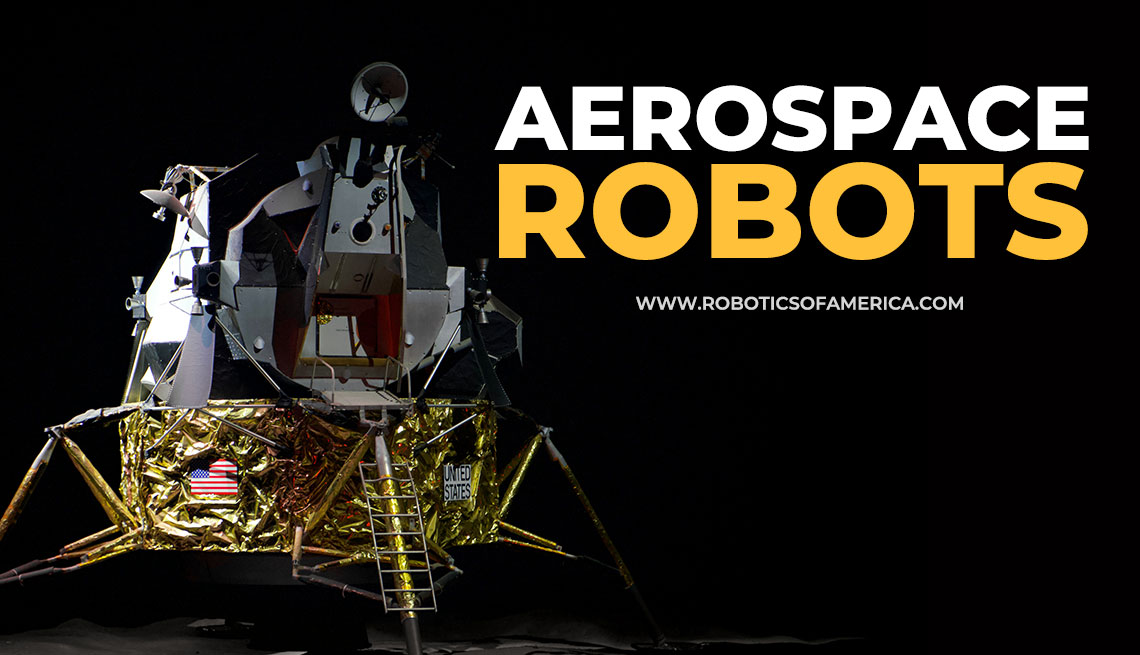
The Amazing World of Aerospace Robots
Automation innovations have led to a growing number of aerospace robots. These robots are turning the aerospace industry upside down. Why? Because they offer so many benefits that save companies both money and time. Due to high value production, the robots cut huge operating costs for these companies.
The aerospace industry used to have a a conservative approach when it came to processes. But robotic applications have made this notion very outdated. In fact, robots are becoming leaders of aerospace applications. This article will explore what those key applications are. Whether making inspections or painting, there's little limit to what these machines do. Are you ready to learn more about aerospace robots? Let’s get started.
The 5 Main Responsibilities of Aerospace Robots
1) Aerospace robots do fastening and drilling.
What is the largest area that aerospace robots take care of? Fastening and drilling. A robot’s drilling techniques involve three key steps:
- Pilot hole drilling.
- Final sized drilling.
- Reaming processes.
When an aerospace robot does manual drilling, it has to use a very large and complicated jig. This is one reason why robots are doing a task like this instead of humans. Many aerospace tools are so powerful that humans lack the strength to operate them. Robots are able to drill exotic, tough materials like titanium. This is something that humans have struggled to do for centuries. In order for a human to do this sort of drilling, a specific jig has to get created. But with aerospace robots, no specific jig’s required. Instead, the robots use their own vision system. This allows them to drill each hole with precision. The necessary spots get drilled without any confusion or difficulty.
What is another key advantage of robotic aerospace drilling? A single pass is all it takes to conduct the drilling steps. A team of humans would never be able to do all the steps in one pass. What does this mean? Robots have become a huge time-saver for aerospace companies. For instance, take fuselages. Each fuselage requires thousands of small holes to get drilled. Manual drilling would almost be impossible for these fuselages. But robots can take care of the drilling very fast.
2) The inspector role of many aerospace robots.
That’s right- aerospace robots are able to conduct inspections. This is critical for manufacturing aircrafts of any kind. You see, tolerances are very limited. Plus, companies get bombarded with inspection requests all the time. Aerospace robots can perform all the important inspection procedures. These are action that humans used to get tasked with. And human inspections take a lot longer than robot inspections do. But humans are not 100% obsolete when it comes to the inspection process. For example, say an aerospace robot drills a bunch of holes. The appearance of those holes still needs to get approved by a human supervisor.
Each aerospace robot has an end-effector. The end-effector features measuring probes and a laser scanner. Say the drilling process on a project is complete. The robot then uses a laser scanner to check out the work that has gotten done. The scanners are capable of gathering a lot of various information in a short amount of time. For example, the aerospace robot can measure the quality of the countersinks. As if that weren’t enough, it can then measure the surface characteristics with accuracy.
Next, the robot uses a non-contact bore probe. The probe measures the bore depth and the diameter of the holes. But the aerospace robot is not done with its inspection process. The next step is for the robot to detect an exit burr or liquid shim blowout. The robots uses its scanner to do so. Keep in mind that aerospace robotic inspections do not focus very much on safety. A robot’s role is to inspect for quality defects.
An aerospace robot’s inspection/testing process is almost always destruction-free. This destruction-free testing ensures the aerospace parts are in sync with one another. Most aerospace robots conduct three key tests:
- A delimitation test.
- A test for cracks.
- Fastener inspections.
All three of these important actions take place before each assembly process comes to an end. Every aerospace robot's equipped with state-of-the-art metrology/ultrasonic inspection abilities. Let’s use OC Robotics’ own aerospace robot as an example. This robot has one of the most advanced flexible arms in the aerospace industry. The arm is able to reach restricted sections of aircrafts. An advanced arm like this matters a lot. These arms are making aerospace inspection processes efficient and precise.
3) Aerospace robots excel at welding.
Aerospace robots can weld better than most humans can. Sure, composite parts are becoming more and more popular. But many aircrafts still need metal parts to function. Aerospace companies cannot get lackadaisical when it comes to metal part welding. This assembly process has to be perfect. Otherwise, major future problems are going to occur. This is another reason why aerospace robots are so important. Their precision-levels help key actions get taken care of in the best possible ways. This applies to many metal part welding procedures such as turbine welding.
Your average aerospace robots are masters of using exotic materials. These robots know how to weld materials such as nickel-alloy and titanium into motors. And their accuracy levels far surpass human welders. Many aerospace companies are raving about tight tolerance achievements. Due to how successful robots are at welding, many human welders are no longer needed. But don't assume that their aerospace jobs are 100% obsolete. The common task of the average aerospace welder is to check on the work of the robots. This is for both safety and quality control purposes.
4) Dispensing and sealing are two more activities that aerospace robots do.
Here come the aerospace robots to the rescue again. Why? Because manual operators have suffered for decades to dispense and seal. But nowadays, robots can do these tasks faster and with more accuracy. Aerospace robots can:
- -add sealant
- -add paint
- -add metal and other materials
- -add ceramic coatings
All the above actions are very difficult for humans to do. Especially when it comes to working with large framing parts and huge fuselages. The size of many parts are too big for human operators to grasp. Thus, it makes sense why aerospace companies would turn to robots. The robots can take care of the applications fast and with tremendous accuracy. Many companies choose to put robotic arms on rails. This is because working cells often cover huge distances. The distances can sometimes extend forty feet. In other words, they are often at least two stories tall. Aerospace robots, of course, have no fear of falling down. They can scale these vast distances fast. The robots’ dispensing processes ensure that each mission goes well.
5) Aerospace robots are great at rigid manufacturing.
There’s no way around it- aerospace robots are masters when it comes to rigidity. Aerospace manufacturing would not be where it is today without robotic rigidity capabilities. The key robotic advantage here is that robots are more precise than humans. And their precision abilities are growing stronger as technology continues to evolve. Why do robots need to be so accurate to conduct rigid manufacturing processes? It is due to the following three factors:
- Rigid manufacturing involves tight tolerances.
- Rigid manufacturing has tons of repeatability requirements.
- Rigid manufacturing requires many precise manufacturing maneuvers and strategies.
As you can infer, an aerospace robot must maintain accuracy 100% of the time. Otherwise, a company’s rigid manufacturing processes are going to slow down. This delays the creation of many aircrafts. One solution many companies have come up with is to take advantage of secondary encoders. This is because a lot of organizations do not trust the original encoders in a robot’s joints. Aerospace engineers go out of their way to implant robots with secondary encoders. The secondary encoders display the exact position of each robot’s joints. This leads to human operators having better control of each robot. Accuracy increases and backlash gets minimized. Not to mention, secondary encoders cut down on the settling time. Why? Because aerospace robots have a better reaction time for drilling processes than humans.
Conclusion: Aerospace Robots Have Improved So Many Processes
As you can see, there are very few limits to what aerospace robots can do. They have revolutionized the entire aerospace industry in recent years. This is an industry that was always known for its conservative manufacturing processes. But robots are changing that perception more and more each day. Robotization has led to aerospace companies having better ROI and profit margins. Your company is capable of experiencing similar success. That’s why you should contact Robotics of America today. Our experts will tell you more about how robots are benefitting companies. And not only aerospace companies. Robots are saving companies of all industries millions of dollars per year. Please come back to our website in the future to read articles on related topics such as:
- -types of aerospace robots
- -consumer robots
- -who created aerospace robots
- -aerospace robotics companies
- -who makes aerospace robots
- -medical robots
- -aerospace robot names
- -robotic aerospace applications

